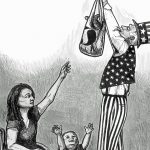Restrictions on Food Stamps are Cruel and Pointless
Moochers. Freeloaders. Lazy parasites who won’t get a job because they just want free stuff. Despite being bolstered by outrageous falsehoods (right-wing author David Barton once falsely claimed that the average family on welfare receives $61,000 a year from the federal government), these all-too-familiar stereotypes about people who receive public assistance pervade the American political climate.
These stereotypes couldn’t be further from the truth. According to a 2012 analysis by the Center for Budget and Policy Priorities, only about 10% of welfare spending goes toward the “non-working poor”—people who are technically able to work, but for whatever reason, don’t have a job—leaving 90% to pay for the people who either do work or are physically unable to. Another study by MIT and Harvard, done across several countries, showed that welfare recipients worked the same number of hours after receiving welfare as they did before, and that they were more likely to start businesses than other Americans.
Some might argue that while welfare itself isn’t a bad idea, the real problem is the fraud that happens when people exploit legal loopholes. In reality, even what does actually count as welfare fraud is more complicated than it looks.
“The cash benefits available under [TANF, a federal program] are too low to sustain a family,” explains Kaaryn Gustafson of the Northwestern University School of Law. “The gap between resources and need often leads welfare recipients to seek income to supplement their welfare benefits and to hide that income from the welfare office.”
“[T]he vast majority of welfare recipients are technically welfare cheats,” she adds. “If they were not, they would be unable to survive.”
So, it’s far from greedy.
That hasn’t stopped legislators from trying to enforce what they deem an appropriate level of asceticism among the poor. Currently, people enrolled in the Supplemental Nutrition Assistance Program (SNAP), more commonly known as food stamps, are banned from buying hot food, food they will eat in a store, or food in restaurants.
Basically, you can only buy food that you prepare yourself. For many poor people—who may not have the time or equipment to do so—this makes things pretty difficult, especially on the $29/week budget that the average person on food stamps receives.
Now, people with low incomes often have to consume more calories than the average person. Many work physically intensive jobs that require a lot of energy. They also may have to walk more often for transportation, because they can’t afford cars.
However, they’re frequently forced into a choice between getting these calories, or getting actual nutrients. Healthy fruits and vegetables may be good for you, but they aren’t calorically dense enough for a person to survive on. In order to get enough bang for such a small amount of buck, people on food stamps end up having to buy cheap food that’s rich in carbohydrates and fat, though low in nutrients, in order to survive.
This isn’t healthy, and it’s probably why food-stamp recipients are slightly more likely to be obese than the rest of the American population. However, with the aforementioned stereotypes playing an important role in their decision, legislators are going about this issue in all the wrong ways.
In Missouri, legislators have proposed rules prohibiting food stamps from being used for lobster, cookies, and other “luxuries,” while Maine is thinking about banning junk food. In addition, Wisconsin has proposed laws restricting their use to “healthy” food while banning the purchase of shellfish, with one of its co-sponsors, Rep. Scott Allen, citing the cost of preventable diseases as a reason for the bill.
Neither has been passed yet—or is likely to—as federal law currently prohibits states from doing so. But, as mentioned earlier, SNAP users already face plenty of restrictions, which are what’s causing the problem in the first place. The proposed regulations restrict access to foods that, while imperfect, are the only thing that recipients can live off of.
If legislators really cared about the problem, they’d just give people more money.
That, and people just have a right to choose what they eat. If somebody wants to save up and eat plainly—or not enough—so they can enjoy a nice meal with lobster, why can’t they? If a parent feels like getting their kids soda as a treat every once in awhile, who are you to stop them?
Even the pre-existing restrictions on SNAP usage ought to be rolled back. They hit the poorest people the hardest—if you’re homeless, or just can’t afford a way of preparing food, how can you eat anything? How can you get hot food at all, if you can’t buy it already heated up?
It’s not like these rules even save the government any money, so they may seem illogical. In reality, they are not random at all, but part of an insidious, calculated agenda. The restrictions serve to humiliate the poor, blaming them for their misfortune and perpetuating the stereotypes of lazy “welfare queens.”
These attitudes, combined with the restrictions themselves, serve to deter people eligible for public assistance from signing up. After a wide-reaching series of punitive welfare reforms were passed in 1996, enrollment fell from 84% of eligible families in 1995 to only 40% in 2005. This tragically pushes needy families into either the for-profit prison system or into low-wage, exploitative jobs, where they dare not ask for better pay or conditions because they have nothing to fall back on if they’re fired.
The classism inherent in these proposals also sets the stage for actual cuts to welfare. If the poor are seen as undeserving, it won’t take long for people to decide that what little they’re getting is too much.
When people learn to demonize the poor, it distracts from—and even rationalizes—the extreme inequity throughout the country. It’s useful to tell people they deserve what they get. How else would they demand more?





